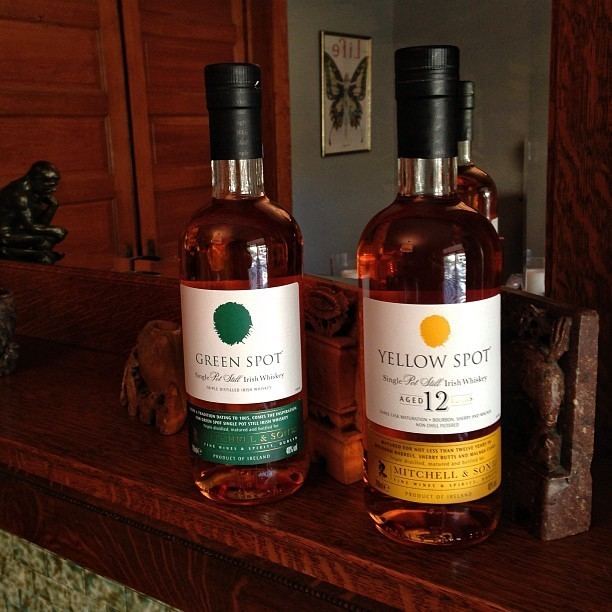Type Whiskey Alcohol by volume 40–94.8% | ||
 | ||
Colour Pale Gold to Dark Amber | ||
Single pot still whiskey is a style of Irish whiskey made by a single distillery from a mixed mash of malted and unmalted barley distilled in a pot still. Somewhat similar to single malt whiskey, the style was defined by its inclusion of unmalted raw barley in the mash in addition to malt. However, on occasion, small amounts of raw oats or wheat may also have been used. This unmalted component is said to give single pot whiskey a "spicier bristle" and "thicker texture" than the otherwise similar single malt whiskeys. If the whiskey is not distilled totally on the site of a single distillery, then it may be termed pot still whiskey, but not single pot still whiskey.
Contents
Once the most popular type of whiskey in the world, the style of whiskey was historically referred to as pure pot still whiskey, Irish style pot still whiskey, or, especially in Ireland, simply as pot still whiskey. The term "single pot still" only being introduced in recent years to overcome objections from the United States Tax and Trade Bureau to the use of the term "pure" in this manner in the labelling of food and drink.
The term should not be confused with the theoretical concept of whiskey produced solely in a pot still (which would also apply to single malt whiskey as well as some examples of pot still bourbon and rye whiskey).
History
Whiskey has been distilled in Ireland from at least the 1400s, and likely as early as the 6th century. However, single pot still whiskey emerged as a means of avoiding a tax on the use malted barley introduced in 1785. Although this tax was later repealed, the style endured in popularity until the emergence of blends in the late 19th and early 20th century.
In the 1800s, single pot still whiskey was the most popular style of whiskey in the world, and formed the bulk of Ireland's whiskey exports. However, with the rise of cheaper, milder blends in the 20th century, pot still whiskey declined in popularity. So much so, that by 1980 only two specialist bottlings remained in existence, Green Spot and Redbreast, with one in danger of being discontinued. Other pot still whiskeys having either been reformulated as blends, or discontinued. However, since then a resurgence in whiskey distilling in Ireland has seen the launch of several new single pot still whiskeys.
Legal definition
In addition to the general regulations governing the production of Irish whiskey (e.g. geographical origin, aging in wooden casks for a minimum of three years), Irish Government regulations stipulate that "Irish pot still whiskey" is to be:
In addition, the regulations state that:
Whiskeys
As of 2016, there are handful of single pot still whiskeys on the market. However, due to the construction of several new distilleries in Ireland in recent years, several more single pot whiskeys are expected to be released in coming years. Those currently available include:
